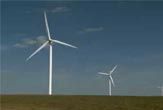Wind Farms Alter Local Weather

Scattered across fields like colossal pinwheels, wind turbines could be responsible for more than churning out electricity. They could be changing local weather.
Researchers have found that under certain conditions at one wind farm studied, large wind turbines can alter local temperatures, sometimes by as much as 2.7 degrees Fahrenheit (1.5 degrees Celsius). While climate models have shown the possibility of such an impact, this is the first time that real data has been used to confirm the phenomenon.
"As wind farms become larger and more ubiquitous, it is essential that their possible environmental costs and benefits are assessed and properly addressed to ensure the long-term sustainability of wind power," the researchers state in their paper published online Oct. 4 in the Proceedings of the National Academy of Sciences.
These giant wind turbines create wakes, similar to the ripples of water produced as a boat zooms through the water, that cause the local air to mix vertically, said Somnath Baidya Roy, a professor at the University of Illinois and lead author of the new study. "What it does is it takes low level air and mixes it with upper level air," Baidya Roy told TechNewsDaily.
The mixing heats up the air at night and in the early morning, and cools air during the day.
To avoid changing the local climate, the researchers suggest designing rotors that generate less turbulence.
“This is a win-win solution because these rotors are also more efficient,” the researchers write. “They can generate more power by harnessing the energy that would be otherwise lost as turbulence.”
Sign up for the Live Science daily newsletter now
Get the world’s most fascinating discoveries delivered straight to your inbox.
Another solution is to build wind farms in high-turbulent areas, where the turbulence created by the turbines would be negligible. Examples include large parts of North and Central America, the southern tip of South America, northern Europe, Russia, northern China, the Rift Valley, and southern parts of Africa, southern Australia, and New Zealand.
The researchers used temperature data collected during the period of June 18 to Aug. 9, 1989 for a wind farm at San Gorgonio, Calif. — the only wind farm with available temperature data.











